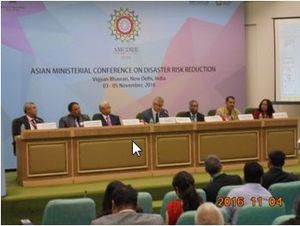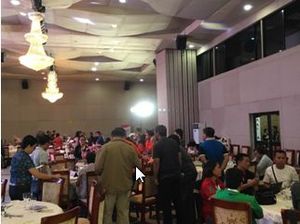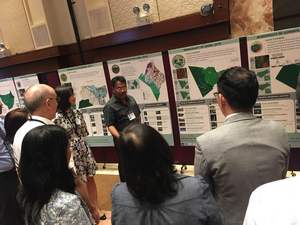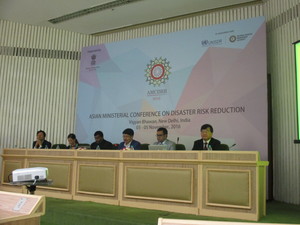New Delhi, India (November 4, 2016)
 The International Recovery Platform, where ADRC is pioneering member, coordinated a thematic session at the Asian Ministerial Conference on Disaster Risk Reduction, 3-5 November 2016 in New Delhi, India. The session was entitled "Strategies and Actions on Build Back Better" held on 4 November 2016, 13:00-14:30, Hall 6 at Vigyan Bhawan. Six high-level speakers of the session shared their respective experiences and lessons relative to: (i) policies and strategies, (ii) institutional arrangements, (iii) financing mechanisms, and (iv) implementation arrangements and recovery management - the key elements relevant to build back better. About 150 individuals participated in the session, where each speaker outlined key strategies and actions for build back better ranging from the areas of governance, gender, pre-investment, social inclusion, and sustainable development.
The International Recovery Platform, where ADRC is pioneering member, coordinated a thematic session at the Asian Ministerial Conference on Disaster Risk Reduction, 3-5 November 2016 in New Delhi, India. The session was entitled "Strategies and Actions on Build Back Better" held on 4 November 2016, 13:00-14:30, Hall 6 at Vigyan Bhawan. Six high-level speakers of the session shared their respective experiences and lessons relative to: (i) policies and strategies, (ii) institutional arrangements, (iii) financing mechanisms, and (iv) implementation arrangements and recovery management - the key elements relevant to build back better. About 150 individuals participated in the session, where each speaker outlined key strategies and actions for build back better ranging from the areas of governance, gender, pre-investment, social inclusion, and sustainable development.
H.E. Vongthep Arthakaivalvatee, Deputy Secretary-General ASEAN Secretariat, reported that ASEAN is setting forward a regional policy on build back better based on the recovery and reconstruction component of the ASEAN Agreement on Disaster Management and Emergency Response (AADMER). The regional policy sets forth the process and the timeframe for assessment, recovery plan formulation, resource mobilization, coordination, and transition of recovery plan to development plan so that member states are guided. With the AADMER in place, member states are about to improve safer structural and non-structural measures during reconstruction. Other specific examples of regional efforts include Tripartite Core Group partnership in recovery from cyclone Nargis in Myanmar as well as development of guides such as the Recovery Toolbox and the Disaster Recovery Reference Guide.
Mr. Sushil Gyewali, Chief Operating Officer of National Reconstruction Authority of Nepal, shared the key challenges of the Post-Disaster Recovery Framework 2016-2020. In terms of policies, the challenges include managing political interests, community expectations, compliance to build back better principle, and operations of the new National Reconstruction Authority that adopts a new perspective but with old team. In terms of institutional arrangement, the challenges are institution building against the pressure of delivery as well as the capacity to deliver reconstruction that complements national resources with international expertise. In terms of financing mechanism, the challenges include ensuring international commitment, financing, and realistic recovery planning and implementation. In terms of recovery management, a robust and decentralized reconstruction coordination and implementation mechanism was designed and instituted as well as engaging community.
Mr. Austere Panadero, Undersecretary at the Department of the Interior and Local Government of the Philippines, highlighted the key initiatives that help address the gaps in DRR and recovery efforts. In terms of policies, land use plan is the 'mother' of all plans and the basis for 'build back better' at the local/community level. Additionally, hazard-proofing of public investments is advocated through planning-programming-budgeting linkages as well as better DRRM-CCA informed criteria for project development and evaluation. In terms of institutional arrangements, the barangay-level or village-level DRRM-CCA baseline information is being generated locally and communities are strengthened through capacity building activities down to the household levels. In terms of financing mechanisms, initiatives such as Climate Change Expenditure Tagging (CCET) and the Seal of Good Local Governance through disaster preparedness audits are put in place. Finally, in terms of recovery management, a seamlessness of local development plans such as those drawn from Typhoon Haiyan experience in the Visayas and the "whole-of-government" approach under NDRRMC-OCD are among the many examples of tried and tested implementation arrangements.
Prof. Vinod Menon, Senior Advisor Caritas India, pointed that community-centered policies are essential. He introduced the "Community-Centered Risk Management" Framework for build back better, emphasizing inclusive recovery with special attention to the weak and marginalized groups. The framework was presented to be one of the solutions to address existing policy gaps as it facilitates: (i) coherence and convergence of policies relative to DRR, CCA, and SDGs; (ii) inclusion of the weaker sections of society as the hallmark of all recovery strategies; and (iii) support for resilience building of communities affected by ethnic conflicts, atrocities against vulnerable sections, violence and complex emergencies.
Mr. Achyut Luitel, Director of Practical Action Nepal, introduced the South Asian Disaster Report 2016, which outlines 12 recommendations for build back better in Nepal, namely: (1) promote multi-tier, multi-stakeholder policy directions; (2) harmonization and standardization of policy, legislative, and regulatory instruments; (3) ensure institutional demarcation for phase-out planning and implementation; (4) holding institutions accountable for addressing DRR in development interventions; (5) focus on vulnerable within vulnerable; (6) enable the potential and capacity of women as decision-makers; (7) make housing reconstruction owner-driven; (8) make schools safe for children; (9) building on local solutions; (10) move from cash transfer to risk transfer; (11) rebuilding micro and small enterprises; and (12) building disaster risk-informed development for resilience.
Ms. Shaila Shahid, Team Leader Gender and Water Alliance Bangladesh, highlighted two policy actions, namely: (i) inclusion/awareness raising, where in the case of Bangladesh, actions such as participation of women in disaster management councils and local government, volunteerism, and representation in the management bodies are promoted; and (ii) capacity building focusing on understanding gender, identifying social relations between men and women, and how these relationships are socially constructed to encourage leadership role.
After active discussions, Mr. Stefan Kohler of UNOPS and chair of the session offered the summary. First, recovery phase is an opportunity to build back better, which is essential to reduce vulnerability and make the development gains more sustainable. It can be more successful of done with inclusion of the weak and marginalized. Second, pre-investment is an important element for build back better to ensure development continuity, such as promoting risk-informed land use planning. Third, awareness, knowledge, and capacity such as in reference to gender and marginalized groups are essential in facilitating effective preparation to build back better in recovery, rehabilitation, and reconstruction Finally, build back better in recovery is a large-scale institutional and technical effort, which requires all the stakeholders--government, civil societies, and private sector --to collaborate and work together such as the whole-of-government approach of the Philippines.
(2016/11/04 14:40)






